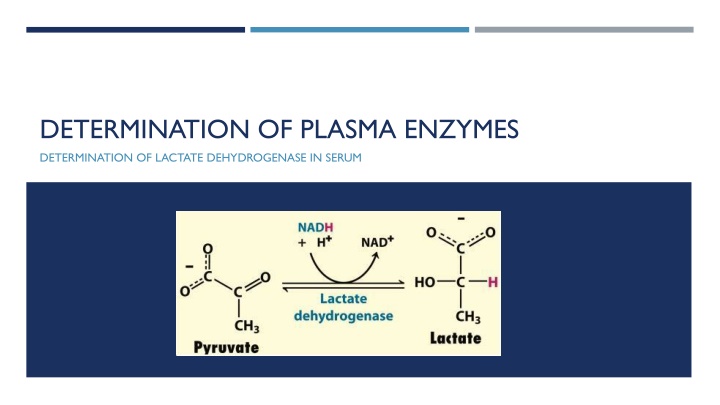
Plasma Enzymes and LDH in Serum
Learn about the importance of determining plasma enzymes and evaluating LDH levels in serum to assess tissue damage. Discover the classification of plasma enzymes, the significance of non-functional enzymes, sources of non-functional enzymes, and the medical importance of measuring them for disease diagnosis and prognosis.
Download Presentation

Please find below an Image/Link to download the presentation.
The content on the website is provided AS IS for your information and personal use only. It may not be sold, licensed, or shared on other websites without obtaining consent from the author. If you encounter any issues during the download, it is possible that the publisher has removed the file from their server.
You are allowed to download the files provided on this website for personal or commercial use, subject to the condition that they are used lawfully. All files are the property of their respective owners.
The content on the website is provided AS IS for your information and personal use only. It may not be sold, licensed, or shared on other websites without obtaining consent from the author.
E N D
Presentation Transcript
DETERMINATION OF PLASMA ENZYMES DETERMINATION OF LACTATE DEHYDROGENASE IN SERUM
OBJECTIVES To determine the level of LDH in serum. To evaluate the presence of tissue damage.
PLASMA ENZYMES Plasma proteins, also termed serum proteins or blood proteins, are proteins present in blood plasma which have several functions. Some blood proteins also act as enzymes These enzymes are classified into functional and non-functional enzyme
NON FUNCTIONAL PLASMA ENZYME Very small amount of the enzymes are released in blood as a result of normal turnover of cells of different organs. Hence under normal condition the enzymes are present in very small amount in blood where they have no specific function, so termed as plasma nonfunctional enzyme
INCREASE OF NON-FUNCTIONAL PLASMA ENZYME Tissue damage or necrosis resulting from injury or disease is generally accompanied by increases in the levels of several nonfunctional enzyme
SOURCES OF NON-FUNCTIONAL ENZYMES Cell damage with the release of its content of enzymes into blood e.g. Myocardial infarction and viral hepatitis Obstruction of normal pathways e.g. Obstruction of bile duct increases alkaline phosphatase Increase of the enzyme synthesis e.g. bilirubin increases the rate of synthesis of alkaline phosphatase in obstructive liver disease Increased permeability of cell membrane as in hypoxia So estimation of the plasma concentration of these enzymes in blood is useful for the diagnosis of disease depending on their tissue origin.
MEDICAL IMPORTANCE OF NON FUNCTIONAL ENZYMES Measurement of non functional enzymes is important for: Diagnosis of diseases Prognosis of the disease: following up of the treatment by measuring plasma enzymes before and after treatment.
LACTATE DEHYDROGENASE (LDH) LDH is a hydrogen transfer enzyme which catalyzes the interconversion of pyruvate and lactate. Lactic acid dehydrogenase (LDH) is an enzyme that helps produce energy. LDH is most often measured to evaluate the presence of tissue damage (diagnostic) The enzyme LDH is in many body tissues, especially the heart, liver, kidney, skeletal muscle, brain, blood cells, and lungs.
LACTATE DEHYDROGENASE (LDH) The optimum pH for lactate pyruvate (L P) reaction is 8.8 9.8 While for pyruvate to lactate (P L) is 7.7 7.8.
LDH ISOENZYMS LDH exists in 5 forms (isoenzymes), which differ slightly in structure. All of these isoenzymes can be measured in the blood, and can be separated by electrophoresis. LDH Isoenzyme LDH-1 Tissues is found primarily in heart muscle and red blood cells. is concentrated in while blood cells. LDH-2 LDH-3 LDH-4 is highest in the lung is highest in the kidney, placenta, and pancreas is highest in the liver and in skeletal muscle LDH-5
HIGH LDH IN PLASMA Diseases Examples Myocardial infarction Toxic jaundice Viral hepatitis Obstructive jaundice Pernicious anemia Megaloblastic anemia Tubular necrosis Liver Disease High LDH in plasma Anemia Renal Diseases Pyelonephritis Malignant Disease Lung Cancer Hodgkin s disease
RESULTS Absorbance at 340 nm Time (min) A1 1 A2 2 A3 3
CALCULATIONS A1= A2 -A1 A2 = A3 A2 A/min = ( A1 + A2) / 2 LDH (U/L) = A x 4984 Normal Values 109 to 245 U/L




